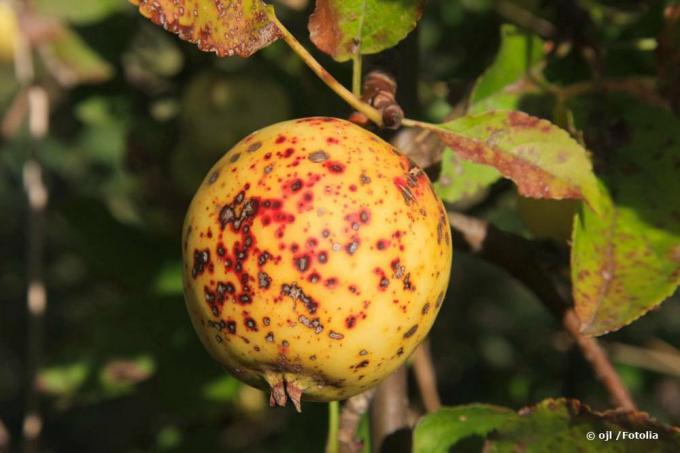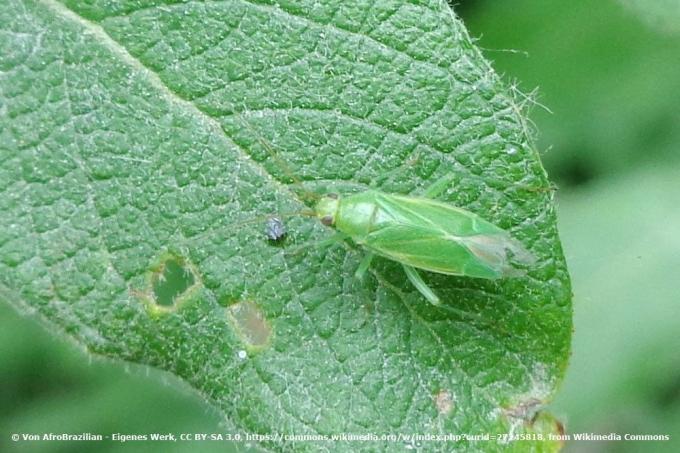
table of contents
- Causes of leaf damage on the apple tree
- Diseases
- Apple scab
- Collar rot
- Marssonina leaf spot disease
- Pest infestation
- Apple rust mites
- Fruit tree spider mite
- Apple bug
- Mealy apple aphid
- Stress-related causes
Apples are healthy and they still taste best from your own tree. When looking for the right apple variety, you can choose between different flavors, colors and harvest times. In some cases it is even possible to dispense with a pollinator variety. But despite all the joy of self-harvested fruit, apple trees can also be affected by disease or pests. Yellow, blotchy leaves or premature leaf fall may indicate this.
Causes of leaf damage on the apple tree
If the apple tree shows yellow, brown spotted leaves or loses its leaves prematurely, this can have several causes. Most of the time, these symptoms appear together with others, making it difficult to pinpoint the exact cause. In addition, many apple varieties show insufficient resistance, which increases their susceptibility. Fungal diseases and pests can be responsible for such damage, and physiological disorders, i.e. stress, cannot be ruled out as a cause.
Diseases
Apple scab
Apple scab, a disease caused by Venturia inaequalis, is one of the most important apple tree diseases. High temperatures and humidity in spring or prolonged wetness of the leaves favor an infestation. But also small brown spots on and under the leaves, which slowly get bigger and converge, can be signs of an infestation. In the case of early infestation, often only the tips of the sepals are affected, later usually the entire leaf. Then they die, the tree is bare.

Combat
Since this fungus overwinters in the leaves, fallen leaves should be completely removed from the ground. Otherwise a renewed infestation is inevitable. To inhibit the development of the fungus, a layer of mulch on the tree disc can be helpful, but not right up to the trunk and no bark mulch. The crown should also be thinned out by regular trimming in winter so that the inside of the crown is better ventilated.
tip: In order to counteract diseases in general, you should opt for resistant varieties when buying.
Collar rot
- Collar rot caused by fungi of the genus Phytophthora
- Trees show reduced growth
- Leaves initially yellowish, later reddish in color
- Tree loses leaves prematurely
- Fruits stay smaller, are more intensely colored (emergency ripeness)
- Individual branches die off
- Because disease progresses slowly
- Apple tree dies within two to four years
Combat
In the case of light infestation, cut off the affected parts of the plant and treat the resulting interfaces with an agent against fruit tree cancer. But once the collar rot has progressed, the apple tree usually has to be felled. Nevertheless, one should pay attention to resistant varieties as a preventive measure, avoid damaging the grafting point and remove windfalls regularly. In addition, the tree grate should be covered with compost or mulch in such a way that approx. 10 cm remain free.
Marssonina leaf spot disease
- Occurs around July and August during longer periods of rain
- Diplocarpon mali mushroom overwinters in fallen leaves
- Infects the leaves at the beginning of the flowering period
- Permanently wet leaves and temperatures above 20 ° C favor infestation
- Infested leaves are spotted brown
- Spots run into one another over time
- Large areas later discolored yellow
- Partly necrotic speckles with red-violet bordered spots

Fungicides, which are also used to combat apple scab and apple powdery mildew, are suitable for combating. Regular pruning of the fruit tree ensures that all areas are well ventilated.
tip: Careful removal of fallen leaves in autumn reduces the risk of renewed infestation.
Pest infestation
Pest infestation occurs mainly in spring and summer. Some pests use the apple tree as a breeding ground for their offspring, which then eats young leaves, shoots and flower buds after winter. Several pests can be the cause of the leaf damage mentioned.
Apple rust mites
- Indications of the apple rust mite initially yellowish and later rusty-brown spotted undersides of the leaves
- The top of the sheet is dull and dull
- As a countermeasure, remove infected branches and use natural predators such as predatory mites
- Do not dispose of clippings on the compost
Fruit tree spider mite
- causes fine whitish leaf spots
- Leaves later dull, discolored to a silvery bronze color, tree loses leaves early
- Negative effects on flower bud set and fruit color
- Fight against natural enemies such as lacewings, ladybugs and spiders.
- Use of chemical sprays in spring only in exceptional cases, they also kill the natural enemies of the mites
Apple bug
- Small holes and brown leaf spots can indicate an apple bug
- The growth of young shoots is interrupted, fruits show corky spots
- Pests can be shaken off early in the morning, which minimizes infestation
- Use insecticides only in case of severe infestation.

Mealy apple aphid
- Leaves of the apple tree turn yellowish, later brown to black discolorations appear, leaves cripple, curl up and can fall off prematurely
- Shoots are twisted and compressed
- Fruits stay small, wrinkled, and blotchy
- Then cut off heavily infested shoots and use approved pesticides if they occur in large numbers
Stress-related causes
If diseases and pests can be ruled out as the cause of leaf damage, stress or Physiological impairments lead to discoloration, browning or premature leaf fall. Several factors can stress the apple tree:
- Planting in summer heat and drought
- Dried out root ball due to insufficient water supply
- Too firm or stony ground
- Changeable weather conditions
- Young or freshly planted apple trees are particularly vulnerable
- Because roots are still relatively small
- Leaves are not yet adequately supplied with moisture and nutrients
- Tree sheds leaves to protect itself and to create balance

Countermeasures are usually not required. Because if the tree is rooted, it usually recovers relatively quickly. The situation is different if the sap balance is disturbed due to root damage, for example by voles, which causes the leaves to turn yellow. To protect against these rodents, a sufficiently large wire mesh can be placed in the ground when planting and the tree can be placed there.

